実施日 : 2016年03月03日(木) - 04日(金)
Notice: Iwate Prefecture Coastal Area Press Tour “The Fifth Year of Recovery”
投稿日 : 2016年02月12日
Recovery plans including public opinion
Choices for rebuilding lives
From recovery based on outside aid to independence
――Otsuchi――
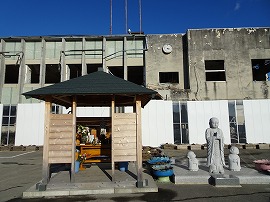 During the Great East Japan Earthquake, Otsuchi was struck by tsunami with a maximum height of 22.2 meters. There were 1,285 deaths and missing persons, nearly 10% of the population, and 60% of homes were damaged. It is one of the municipalities with the highest ratio of lives lost by population. Most of the town was lost to tsunami and fires, and many town officials at the time, including the mayor, perished in the town hall. Therefore, it took longer for the local government to recover than many other municipalities. The recovery of Otsuchi would not have been possible without the tireless efforts of local residents and the support of people from outside the community. Now, nearly five years after the disaster, local residents and their supporters are working to shift from a recovery that relies on outside aid to full independence.
During the Great East Japan Earthquake, Otsuchi was struck by tsunami with a maximum height of 22.2 meters. There were 1,285 deaths and missing persons, nearly 10% of the population, and 60% of homes were damaged. It is one of the municipalities with the highest ratio of lives lost by population. Most of the town was lost to tsunami and fires, and many town officials at the time, including the mayor, perished in the town hall. Therefore, it took longer for the local government to recover than many other municipalities. The recovery of Otsuchi would not have been possible without the tireless efforts of local residents and the support of people from outside the community. Now, nearly five years after the disaster, local residents and their supporters are working to shift from a recovery that relies on outside aid to full independence.
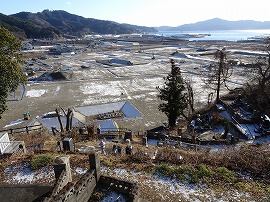
In Otsuchi, the tour will include an interview with the mayor who was elected for the first time last year on a platform of changing the recovery strategy, as well as covering seafood processors cooperating to rebuild their businesses, people living in temporary housing and disaster recovery public housing, and the activities of NPOs helping with employment and education for local residents.
――Taro, Miyako City――
 Having been severely damaged several times in the past by large tsunami, the Taro district of Miyako City was known throughout Japan and the world for its massive levee and for the disaster preparedness of its citizens. However, during the Great East Japan Earthquake, Taro was struck by a 16-meter-high tsunami, and 181 people lost their lives. In response, Miyako City included moving homes to a leveled area of higher ground in the mountains as part of its recovery plan. The levee near downtown is also being raised from a height of 10 meters to 14.7 meters. Nearly five years after the disaster, the leveled mountain area and raised downtown area have been finished. The local residents have all started new lifestyles, having chosen how they will handle the threat of tsunamis and rebuild their lives.
Having been severely damaged several times in the past by large tsunami, the Taro district of Miyako City was known throughout Japan and the world for its massive levee and for the disaster preparedness of its citizens. However, during the Great East Japan Earthquake, Taro was struck by a 16-meter-high tsunami, and 181 people lost their lives. In response, Miyako City included moving homes to a leveled area of higher ground in the mountains as part of its recovery plan. The levee near downtown is also being raised from a height of 10 meters to 14.7 meters. Nearly five years after the disaster, the leveled mountain area and raised downtown area have been finished. The local residents have all started new lifestyles, having chosen how they will handle the threat of tsunamis and rebuild their lives.
In Miyako City, the tour will interview the mayor; visit the high ground and downtown areas which have finished construction and the massive levee that is being built; and cover the choices local residents and business owners have made in rebuilding their lives.
*This press tour is sponsored by the FPCJ.
*This press tour will require participants to bear part of the cost, but is not a profit-making venture.
******************************************************
-----------------------------------------------------------------------------------------------------------------------
Otsuchi
-----------------------------------------------------------------------------------------------------------------------
1. Interview with Otsuchi Mayor, Mr. Kozo Hirano
Incorporating public opinion while working to accelerate recovery
 In August 2015, the second mayoral election since the Great East Japan Earthquake was held in Otsuchi, and Mr. Kozo Hirano was elected as the new mayor. During the election, Mr. Hirano ran on a platform arguing for revising the existing recovery plan in order to better reflect public opinion. In October 2015, he created a review team from different departments at the town hall, and had them evaluate all existing projects into 7 categories such as “continue,” “scale-down,” “put on hold,” and “abandon.” As a result of this review, approximately 30% of projects were revised. For example, part of the old town hall was being preserved as a memorial of the disaster, but it was decided to abandon that project, and dismantle the remains. This decision was made after holding a meeting to explain the situation to citizens and hear their opinions, with the delays in rebuilding the downtown area, the cost of maintenance, and the feelings of residents all considered in the decision. However, a group of high school students and the town council petitioned to delay the dismantling, and so it will not be dismantled this fiscal year. It remains to be seen how the various opinions of the townspeople will be dealt with. The mayor is working on accelerating the recovery process by selecting which projects to focus on, while keeping up communication with residents.
In August 2015, the second mayoral election since the Great East Japan Earthquake was held in Otsuchi, and Mr. Kozo Hirano was elected as the new mayor. During the election, Mr. Hirano ran on a platform arguing for revising the existing recovery plan in order to better reflect public opinion. In October 2015, he created a review team from different departments at the town hall, and had them evaluate all existing projects into 7 categories such as “continue,” “scale-down,” “put on hold,” and “abandon.” As a result of this review, approximately 30% of projects were revised. For example, part of the old town hall was being preserved as a memorial of the disaster, but it was decided to abandon that project, and dismantle the remains. This decision was made after holding a meeting to explain the situation to citizens and hear their opinions, with the delays in rebuilding the downtown area, the cost of maintenance, and the feelings of residents all considered in the decision. However, a group of high school students and the town council petitioned to delay the dismantling, and so it will not be dismantled this fiscal year. It remains to be seen how the various opinions of the townspeople will be dealt with. The mayor is working on accelerating the recovery process by selecting which projects to focus on, while keeping up communication with residents.
Mayor Hirano and other town officials will give interviews on revising the recovery plan, initiatives for rebuilding lives, and visions for the future.
2. Temporary Housing Complexes and Disaster Recovery Public Housing
Kozuchi Temporary Housing Complex No. 8
Issues and continued support on the 5th year of recovery
・The head of residents’ association, Mr. Yasuhiro Haga (66)
・Japan Create, Ltd., Manager, Mr. Yuichi Yahata (53)
・Otsuchi Council of Social Welfare, Lifestyle Support Advisor, Ms. Wakako Usuzawa
Ms. Naomi Sasaki
While some residents of Otsuchi are now living in newly built disaster recovery public housing or homes they rebuilt themselves, 3,000 people, nearly one quarter of the town’s population, are still in temporary housing. The planned disaster recovery public housing is expected to be completed three years later, and when rebuilding homes personally, the increased cost of construction materials is a barrier.

Otsuchi Temporary Housing Complex No. 8 has the second-highest number of residents of the temporary housing complexes in the town, with 193 people in 94 households (as of January 31, 2016). Currently, there are 48 temporary housing complexes in the town, but the town plans to consolidate them down to 12 by the end of fiscal year 2018.
The Otsuchi Council of Social Welfare’s lifestyle support advisors go door-to-door, checking on residents and providing support such as information on public welfare measures. Under commission from the town a recovery support member from Japan Create, Ltd. is stationed in the housing complex’s meeting hall, patrolling the housing complex and helping residents with any issues they may have, as well as helping run the residents’ association.
According to the lifestyle support advisors, now that nearly five years have passed since the disaster, the problems temporary housing residents face have begun to change. At first, residents sought out mental care to deal with their experiences during the disaster, and support to adjust to their new living conditions. However, recently more residents have been moving to the disaster recovery public housing or their homes which have been rebuilt, and those who remain in temporary housing are feeling more isolated.
An Otsuchi town official will provide a general briefing, followed by speaking with temporary housing residents and the advisors who support them about living in temporary housing, and their outlook for the future.
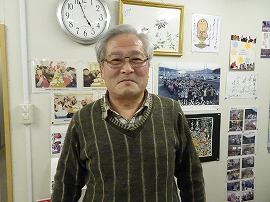
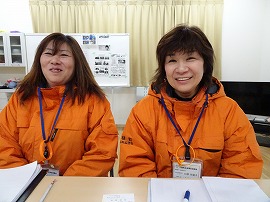
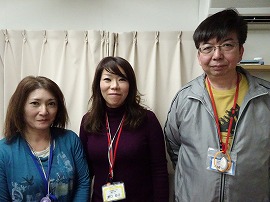
Ogaguchi Icchome Public Housing
Building a community and caring for seniors at disaster recovery public housing
・The head of residents’ association, Mr. Masashi Kawasaki
・Otsuchi Council of Social Welfare, Lifestyle Support Advisor, Ms. Wakako Usuzawa
Ms. Naomi Sasaki
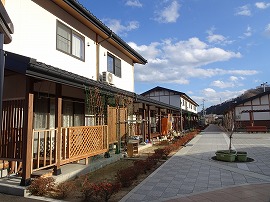 Currently, 328 residences have been completed in Otsuchi as disaster recovery public housing, with a total of 962 planned for completion by fiscal year 2018. The Ogaguchi Icchome public housing complex that people began to move into in August 2013 consists of rows of attached wooden houses built on land that has been raised 1.2 meters. There are a total of 70 homes built to meet the needs of residents with wheelchair accessibility and pets being allowed, and houses for families or people living alone. The complex has a 100% occupancy rate, with 130 people living in 70 households. Of this total, 23 of these households are seniors living alone.
Currently, 328 residences have been completed in Otsuchi as disaster recovery public housing, with a total of 962 planned for completion by fiscal year 2018. The Ogaguchi Icchome public housing complex that people began to move into in August 2013 consists of rows of attached wooden houses built on land that has been raised 1.2 meters. There are a total of 70 homes built to meet the needs of residents with wheelchair accessibility and pets being allowed, and houses for families or people living alone. The complex has a 100% occupancy rate, with 130 people living in 70 households. Of this total, 23 of these households are seniors living alone.
Disaster recovery public housing is intended to help people with low incomes affected by the disaster to rebuild their lives, and there is a tendency for many of its tenants to be seniors. There was also a high proportion of seniors in temporary housing and disaster recovery public housing after the Great Hanshin Earthquake, leading to a high number of kodokushi (people dying alone and not being noticed). Having learned from this, Council of Social Welfare lifestyle support advisors are working at public housing complexes, and carry out periodic home visits to residents. At the Ogaguchi Icchome complex, the residents’ association has been at the center of efforts to build a community among residents.
After a briefing by an Otsuchi town official, the tour will interview public housing residents and the lifestyle support advisors about what life is like in the public housing and what issues exist.


3. Domannaka Otsuchi Cooperative
Four companies cooperating on independence and recovery of the seafood processing industry
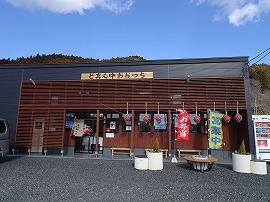 Before the earthquake, there were around 700 people in Otsuchi working in the seafood processing industry, but many companies lost their processing plants and other facilities in the disaster, and currently only about 150 people are back to work in the industry. With many business owners struggling to collect the necessary capital to start their business back up, the owners of four companies that lost their processing facilities to the tsunami (Haga Sengyoten, Urata Shoten, Nakashoku, and Shozushima Fishery) decided to work together on restarting their businesses, and established the volunteer group “Tachiagare! Domannaka Otsuchi” in August 2011. By establishing this group, they were able to take advantage of the group subsidy from cooperation between the national and prefectural governments, provided to SMEs for repairing and restoring facilities and equipment lost in the disaster. Since this subsidy covered three quarters of the cost of repairs, the facilities of each of the four companies are in the process of being rebuilt. In order to expand their sales channels and create a seafood brand for the four companies as a whole, they established a cooperative to operate the Domannaka Otsuchi Shop outlet store and an online store. According to the cooperative’s representative director Mr. Masakazu Haga (70), “Otsuchi cannot survive without the fishery industry. We would like to become self-supported as soon as we can, and provide our customers with products they can rely on.”
Before the earthquake, there were around 700 people in Otsuchi working in the seafood processing industry, but many companies lost their processing plants and other facilities in the disaster, and currently only about 150 people are back to work in the industry. With many business owners struggling to collect the necessary capital to start their business back up, the owners of four companies that lost their processing facilities to the tsunami (Haga Sengyoten, Urata Shoten, Nakashoku, and Shozushima Fishery) decided to work together on restarting their businesses, and established the volunteer group “Tachiagare! Domannaka Otsuchi” in August 2011. By establishing this group, they were able to take advantage of the group subsidy from cooperation between the national and prefectural governments, provided to SMEs for repairing and restoring facilities and equipment lost in the disaster. Since this subsidy covered three quarters of the cost of repairs, the facilities of each of the four companies are in the process of being rebuilt. In order to expand their sales channels and create a seafood brand for the four companies as a whole, they established a cooperative to operate the Domannaka Otsuchi Shop outlet store and an online store. According to the cooperative’s representative director Mr. Masakazu Haga (70), “Otsuchi cannot survive without the fishery industry. We would like to become self-supported as soon as we can, and provide our customers with products they can rely on.”
The tour will hear from Domannaka Otsuchi Cooperative representative director Mr. Masakazu Haga at the Domannaka Otsuchi Shop and visit the processing facilities.
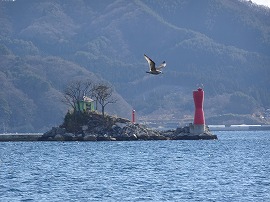
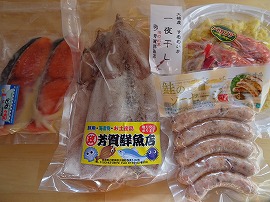
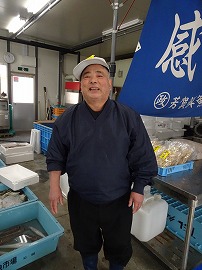
4. Otsuchi Recovery Sashiko Project (NPO Terra Renaissance)
Striving for independence to keep operating in the future
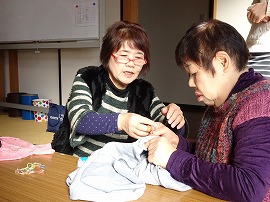 The Otsuchi Recovery Sashiko Project was started to provide women who had lost their homes and workplaces in the disaster with work and a place to feel like they belong. The project was started in June 2011, by Mr. Kazuya Yoshino, a web designer from Tokyo who quit his job and moved to Otsuchi to support recovery efforts. The Sashiko Project involves online sales of products made using traditional sashiko stitching, which can easily be done anywhere as long as needle and thread are available.
The Otsuchi Recovery Sashiko Project was started to provide women who had lost their homes and workplaces in the disaster with work and a place to feel like they belong. The project was started in June 2011, by Mr. Kazuya Yoshino, a web designer from Tokyo who quit his job and moved to Otsuchi to support recovery efforts. The Sashiko Project involves online sales of products made using traditional sashiko stitching, which can easily be done anywhere as long as needle and thread are available.
At first, the Sashiko Project’s main goal was not to provide a source of income, but to provide mental support for participants. The project provided women who lost family and friends in the disaster who were suffering from survivor’s guilt with the chance to focus on stitching instead, and meet other people.
Currently, the project is managed by the NPO Terra Renaissance, which has hired Mr. Yoshino as an employee, and approximately 30 women are involved in stitching. Sales of sashiko products cover about 64% of operating costs, with the rest covered by Terra Renaissance membership fees and donations. Now that nearly five years have passed since the earthquake, they are working on manufacturing products in cooperation with individual designers and major company Ryohin Keikaku Co., Ltd. with the goal of being able to operate independently over the long term. By 2021, they also plan to have a local take over operations of the project.
The tour will speak with Mr. Kazuya Yoshino, who started the project, as well as Terra Renaissance’s local project manager Ms. Mai Yoshida and local residents who are involved in the Sashiko Project.

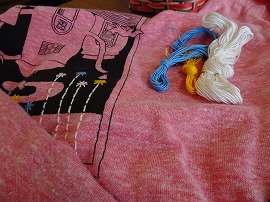

*Sashiko stitching is a kind of traditional Japanese embroidery, particularly well-known in the Tohoku region where it was used to reinforce clothes and help protect against the cold. Now it is often used to make decorative geometric designs, and the Sashiko Project sells products such as coasters, bags, and jackets with original sashiko designs.
5. Collaborative School in Otsuchi (Katariba NPO)
Afterschool study programs raising the next generation
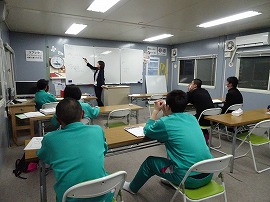 The Collaborative School project is run by certified NPO corporation Katariba, based in Tokyo, and includes afterschool programs for studying that were established in Onagawa, Miyagi in July 2011, and in Otsuchi in December 2011. In addition to providing a place where children living in cramped temporary housing can concentrate on studying, it also uses academic guidance as a way to provide mental and emotional care. Currently, there are 90 elementary school students, 124 junior high school students, and 55 high school students attending the Collaborative School in Otsuchi, with over a dozen staff and instructors working on-site. In both the 2013 and 2014 school years, all the students who attended the Collaborative School passed the entrance exams for the school that was their first choice.
The Collaborative School project is run by certified NPO corporation Katariba, based in Tokyo, and includes afterschool programs for studying that were established in Onagawa, Miyagi in July 2011, and in Otsuchi in December 2011. In addition to providing a place where children living in cramped temporary housing can concentrate on studying, it also uses academic guidance as a way to provide mental and emotional care. Currently, there are 90 elementary school students, 124 junior high school students, and 55 high school students attending the Collaborative School in Otsuchi, with over a dozen staff and instructors working on-site. In both the 2013 and 2014 school years, all the students who attended the Collaborative School passed the entrance exams for the school that was their first choice.
 With nearly five years having passed since the disaster, the Collaborative School not only provides academic support, it also gives children opportunities to learn how to independently contribute to recovery efforts in the future. One example is the “My Project” program, where high school students work to solve issues facing the community. In the 2014 school year, third-year high school student Ms. Misato Maekawa (18) worked on a project to make “Safety Cards” based on her experiences in the disaster. These Safety Cards can be displayed somewhere noticeable by a home in the case of disaster, in order to let family and community members know where the card holder has already evacuated to and that they are safe. Ms. Maekawa won an award in Katariba’s National High School Student My Project Award 2014 contest. Ms. Maekawa commented: “In the future, I hope to include disaster-preparedness education when working as a childcare worker in my hometown of Kamaishi. I would also like to further improve the Safety Cards and distribute them to as many households as possible.”
With nearly five years having passed since the disaster, the Collaborative School not only provides academic support, it also gives children opportunities to learn how to independently contribute to recovery efforts in the future. One example is the “My Project” program, where high school students work to solve issues facing the community. In the 2014 school year, third-year high school student Ms. Misato Maekawa (18) worked on a project to make “Safety Cards” based on her experiences in the disaster. These Safety Cards can be displayed somewhere noticeable by a home in the case of disaster, in order to let family and community members know where the card holder has already evacuated to and that they are safe. Ms. Maekawa won an award in Katariba’s National High School Student My Project Award 2014 contest. Ms. Maekawa commented: “In the future, I hope to include disaster-preparedness education when working as a childcare worker in my hometown of Kamaishi. I would also like to further improve the Safety Cards and distribute them to as many households as possible.”
The tour will visit the Collaborative School in Otsuchi and receive an explanation from Katariba staff, followed by interviewing high school students who participated in the My Project program.
-----------------------------------------------------------------------------------------------------------------------
Miyako City (Taro District)
-----------------------------------------------------------------------------------------------------------------------
6. Interview with Miyako City Mayor, Mr. Masanori Yamamoto
New development efforts in Taro, recovering once more from tsunami damage
Mr. Masanori Yamamoto became mayor in 2009, and has been involved in reconstruction and recovery efforts since the Great East Japan Earthquake in 2011.
 The mayor believes that public consensus on recovery plans is important, and actively incorporated residents’ proposals and opinions into plans for recovery. Therefore, the recovery plan was not completed until a full year after the disaster. The plan included rebuilding the Taro levee and raising the ground of the old downtown area, as well as a major relocation project involving clearing a wide, level area of high ground in the mountains. This plan for relocation to higher ground was mentioned in the national government’s recovery plan after the 1933 Showa Sanriku Earthquake, but the Taro mayor at the time decided instead to build a massive levee, considering technical and cost issues and the opinions of residents, who mostly made their living from fishing. Nearly 80 years later, the mayor and residents have made the decision to relocate to higher ground. To commemorate the raising of the downtown area and the beginning of handing over land for the relocation to higher ground, the Taro Town Opening Ceremony was held on November 22, 2015. In his speech, the mayor stated that “With the cooperation of the national and prefectural governments and other groups, as well as residents, we have come this far in recovery, but it is still a work in progress. We will continue moving forward one step at a time.”
The mayor believes that public consensus on recovery plans is important, and actively incorporated residents’ proposals and opinions into plans for recovery. Therefore, the recovery plan was not completed until a full year after the disaster. The plan included rebuilding the Taro levee and raising the ground of the old downtown area, as well as a major relocation project involving clearing a wide, level area of high ground in the mountains. This plan for relocation to higher ground was mentioned in the national government’s recovery plan after the 1933 Showa Sanriku Earthquake, but the Taro mayor at the time decided instead to build a massive levee, considering technical and cost issues and the opinions of residents, who mostly made their living from fishing. Nearly 80 years later, the mayor and residents have made the decision to relocate to higher ground. To commemorate the raising of the downtown area and the beginning of handing over land for the relocation to higher ground, the Taro Town Opening Ceremony was held on November 22, 2015. In his speech, the mayor stated that “With the cooperation of the national and prefectural governments and other groups, as well as residents, we have come this far in recovery, but it is still a work in progress. We will continue moving forward one step at a time.”
The tour will interview Mayor Yamamoto, and hear about future recovery plans and tsunami countermeasures, primarily for the Taro district.
*For more about the history of tsunamis and the levee in the Taro district, see section 10. Great Levee.
7. Temporary Shopping Center, Taro-chan House
Rebuilding stores, current situation and challenges
・Leader of Taro-chan Cooperative Director/Y shop Taro Hakoichi, Mr. Hideo Hakoishi
・Tanaka Confectionery, Mr. Washichi Tanaka
The Taro-chan House temporary shopping center in Taro, Miyako was started in September 2011, with temporary storefronts of 22 stores that had been damaged in the disaster operating in three two-floor buildings. There are 18 stores still operating there. It is located inside Miyako City’s largest temporary housing complex, Green Pier Sanriku Miyako, and is vital to the daily lives of the 518 residents in 229 households there.
As efforts to rebuild the lives of residents progress, the store owners have begun to reopen their stores in either the downtown with its newly-raised ground or at the new high ground relocation site. Although there was a proposal to collect all the stores in a single location, differences in opinion on disaster preparedness has led to plans for the stores to be rebuilt in different areas. The leader of Taro-chan House, Taro-chan Cooperative Director Mr. Hideo Hakoishi revealed how this has makes people feel conflicted: “Since there are still many residents in the temporary housing complex, some store owners feel guilty about leaving Taro-chan House and reopening elsewhere.”
The tour will interview Taro-chan Cooperative Director Mr. Hideo Hakoishi and Mr. Washichi Tanaka of Tanaka Confectionery about future recovery plans.
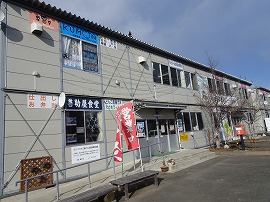
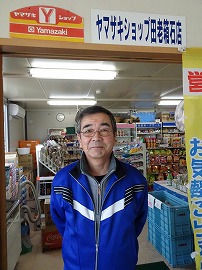
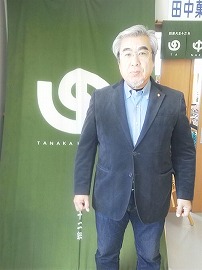
8. High Ground (Sanno Danchi)
The largest housing complex on high ground in Iwate Prefecture.
Residents who have chosen to relocate to high ground.
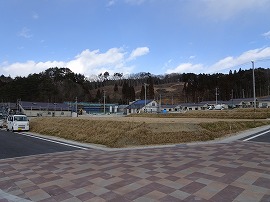 A core principle of Miyako City’s recovery plan is that the areas that are likely to be flooded when the largest tsunamis hit, even with the rebuilt levee, will be relocated to higher ground. Sanno Danchi was prepared as a relocation site on high ground by clearing mountains in the Otobe district. It is one of the largest housing complexes on high ground in Iwate Prefecture, at 25.5 hectares. The plan includes building residences 40 to 60 meters above sea level, higher than the maximum height of the tsunami during the Great East Japan Earthquake, and building public facilities at 30 meters or higher above sea level. 71 residences in 25 buildings are planned to be built for disaster recovery public housing, as well as childcare facilities and a fire station. Five buildings with 36 residences have been completed of the disaster recovery hosing, and people have started to move in. Currently approximately 60 homes are being built on the land prepared for personal homes, with space available for 161 homes, and the area is beginning to liven up.
A core principle of Miyako City’s recovery plan is that the areas that are likely to be flooded when the largest tsunamis hit, even with the rebuilt levee, will be relocated to higher ground. Sanno Danchi was prepared as a relocation site on high ground by clearing mountains in the Otobe district. It is one of the largest housing complexes on high ground in Iwate Prefecture, at 25.5 hectares. The plan includes building residences 40 to 60 meters above sea level, higher than the maximum height of the tsunami during the Great East Japan Earthquake, and building public facilities at 30 meters or higher above sea level. 71 residences in 25 buildings are planned to be built for disaster recovery public housing, as well as childcare facilities and a fire station. Five buildings with 36 residences have been completed of the disaster recovery hosing, and people have started to move in. Currently approximately 60 homes are being built on the land prepared for personal homes, with space available for 161 homes, and the area is beginning to liven up.
The tour will visit Sanno Danchi and listen to a briefing by a Miyako City official, as well as interviewing local residents whose houses are currently under construction.
9. Downtown with Raised Ground
From a temporary shopping center to a successful reopening
・Tsuda Watches and Photography Owner, Mr. Shigeo Tsuda (75)
During the Great East Japan Earthquake, water from the tsunami in the downtown area reached heights from 7 to 14 meters. The downtown area’s tsunami preparedness plan includes the construction of primary (14.7 m) and secondary (10 m) levees, as well as raising by two meters the ground level of the downtown area by the mountain and National Route 45, the main traffic artery for the region. Miyako City has designated areas that are likely to be damaged by future tsunamis as “Disaster-vulnerable Areas,” restricting the construction of residences in those areas, and in the Taro district the area around the levees and on the sea side of National Route 45 have been designated as vulnerable areas.

Mr. Shigeo Tsuda (75), owner of Tsuda Watches and Photography, was running his business in the Taro-chan House temporary shopping center, and in November 2015 he reopened his store in the newly-elevated downtown area. At the time of the Great East Japan Earthquake, Mr. Tsuda’s store was located between Levee No. 1 and National Route 45, and he lost his store and all his equipment to the tsunami. Since the previous location of his store was designated as a disaster-vulnerable area, he decided to reopen in the elevated downtown area, and live in disaster recovery public housing nearby. “The 14.7 meter levee was planned to be completed in fiscal year 2015, but it’s not finished yet,” commented Mr. Tsuda, whose new life has begun despite these worries.
The tour will visit the downtown area which has had its ground raised, and speak with Mr. Tsuda about reopening his store.
10. Great Levee
Protecting residents from the threat of tsunami. Rebuilding the levee with lessons learned
・Miyako Tourism Cultural Exchange Association
Disaster Prevention Education Guide, Ms. Kumiko Motoda (58)
Miyako City’s Taro district (formerly Taro Town) has been devastated by tsunami repeatedly throughout its history. After the 10-meter-tall tsunami that occurred in the 1933 Showa Sanriku Earthquake, Taro Town made a recovery plan that included building a levee. Levees No.1 and No.2 were completed in 1958, with Levee No.3 added in 1978, making a massive X-shaped levee the likes of which existed nowhere in the world. With a height of 10.65 meters and a total length of 2,433 meters, it was called the Great Wall. However, this levee was lower than the 15 meter tsunami that occurred in the 1896 Meiji Sanriku Earthquake, and was built with the intent of buying time for evacuation. Therefore, Taro Town also prepared and labelled evacuation routes to higher ground, and carried out disaster-preparedness training and education for residents.
However, during the Great East Japan Earthquake the district was hit by a 16 meter tsunami that washed over the levees, almost completely destroying Levee No.2, with a total of 181 people dead or missing. Some say that the presence of the levees reassured people, causing these losses, while others suggest that the levees fulfilled their purpose of buying time to evacuate. The Miyako Tourism Cultural Exchange Association started its “Disaster Prevention Education Guide” project in April 2012, with Miyako City residents who experienced the disaster acting as guides teaching about the lessons learned from the massive levee and the importance of disaster preparedness.
Miyako City is currently rebuilding the levee, with reinforcement complete on Levee No. 1, which is now the secondary levee. Instead of Levees No. 2 and No. 3, a new primary levee will be made closer to the sea, with a planned height of 14.7 meters. The completion of the primary levees is one year behind that original schedule, and are planned to be completed in March 2017.
While viewing the downtown area and the planned construction site of the primary levees from atop the secondary levee (Levee No. 1), Disaster Prevention Educational Guide Ms. Kumiko Motoda will provide information.
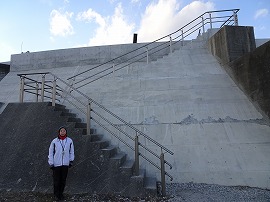
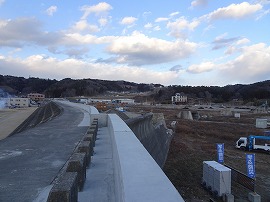
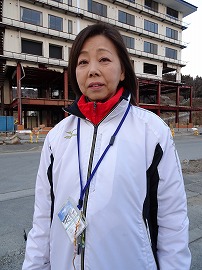
【Tour Outline】
1. Tentative Schedule: March. 3–4, 2016 (Thursday–Friday)
<Day 1 >
7:16 Leave Tokyo Station (Shinkansen Hayate 111)
9:59 Arrive at Shin-Hanamaki Station
(Bus Shin-Hanamaki→Otsuchi 2h15m Lunch)
12:25-12:40 Shiroyama Park (Film/Photograph town)
12:50-13:05 Film/Photograph former town hall
13:20-14:10 Otsuchi Recovery Sashiko Project
14:15-17:00 Temporary Housing Complexes and Disaster Recovery Public Housing
14:15-15:30 Otsuchi Temporary Housing Complex No. 8
15:45-17:00 Ogaguchi Icchome Public Housing
17:15-18:15 Interview with Otsuchi Mayor (The mayor has only 30 minutes)
18:30-19:35 Collaborative School in Otsuchi
20:00 Arrive at hotel (Dinner)
<Day 2>
8:15 Leave hotel
8:30-10:00 Domannaka Otsuchi Cooperative
(Bus Otsuchi→Miyako 1h15m)
11:15-12:15 Interview with Miyako City Mayor
(Bus Miyako city→Taro 45m Lunch)
13:00-13:30 Taro-chan House
13:45-14:35 High Ground (Sanno Danchi)
14:45-15:35 Downtown with Raised Ground
15:45-16:35 Great Levee
(Bus Taro→Morioka 2h50m)
19:25 Arrive at Morioka Station
19:50 Leave Morioka (Shinkansen Hayabusa 36)
22:04 Arrive at Tokyo Station
2. Qualification: Bearer of Gaimusho Press Registration Card
3. Cost: 13,000 yen per person including accommodation, transportation and meal.
* FPCJ will later inform the participants of methods for payment, cancellation fee, etc.
4. Participants: Limited to 15 applicants.
(Only one reporter and one photographer from each company, but two participants from each TV team will be acceptable.)
*If the number of applicants exceeds 15, an upper limit may be set on the number of participants from each country.
5. FPCJ Contact: Ms. Kiyomi Obo (Tel: 03-3501-3405)
6. Remarks:
(1) There may be some restrictions on photographing and filming at the tour sites. Please follow the instructions of the officials on duty.
(2) FPCJ will not be liable for any inconvenience, trouble or accidents that might occur during the tour.



